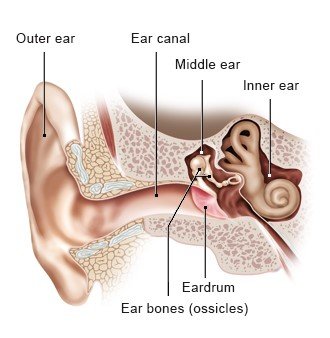The ear has three parts:
- Outer ear (visible part, called the "auricle" or "pinna," and the external auditory canal)
- Middle ear (the eardrum or "tympanic membrane" and the tympanic cavity containing tiny ear bones. These are called the hammer, anvil and stirrup, or "ossicles")
- Inner ear (cochlea and the organ of balance, called the "vestibular system")
Sound waves reaching the outer ear cause the eardrum to vibrate. The vibrations are passed on by bones from the middle ear to the inner ear. This is where the actual organ of hearing, the cochlea, is found. The organ of balance with its three canals is also found in the inner ear.

